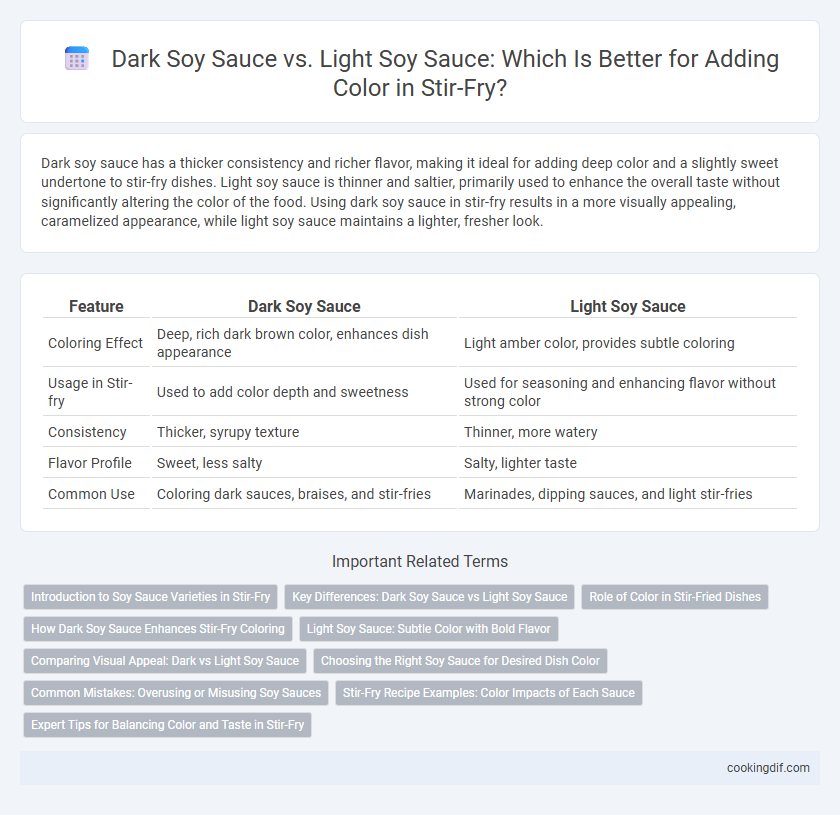Dark soy sauce has a thicker consistency and richer flavor, making it ideal for adding deep color and a slightly sweet undertone to stir-fry dishes. Light soy sauce is thinner and saltier, primarily used to enhance the overall taste without significantly altering the color of the food. Using dark soy sauce in stir-fry results in a more visually appealing, caramelized appearance, while light soy sauce maintains a lighter, fresher look.
Table of Comparison
| Feature | Dark Soy Sauce | Light Soy Sauce |
|---|---|---|
| Coloring Effect | Deep, rich dark brown color, enhances dish appearance | Light amber color, provides subtle coloring |
| Usage in Stir-fry | Used to add color depth and sweetness | Used for seasoning and enhancing flavor without strong color |
| Consistency | Thicker, syrupy texture | Thinner, more watery |
| Flavor Profile | Sweet, less salty | Salty, lighter taste |
| Common Use | Coloring dark sauces, braises, and stir-fries | Marinades, dipping sauces, and light stir-fries |
Introduction to Soy Sauce Varieties in Stir-Fry
Dark soy sauce provides a rich color and thicker texture to stir-fry dishes, enhancing visual appeal and depth of flavor. Light soy sauce offers a lighter color with a saltier taste, making it ideal for seasoning without overpowering the dish's natural ingredients. Combining both soy sauce varieties achieves balanced color and taste, essential for authentic stir-fry recipes.
Key Differences: Dark Soy Sauce vs Light Soy Sauce
Dark soy sauce has a thicker consistency and a richer, mildly sweet flavor that provides deep, dark coloring in stir-fry dishes. Light soy sauce is thinner with a saltier taste and is primarily used to enhance umami and brightness without significantly altering the color. The key difference lies in dark soy sauce's ability to impart a glossy, caramelized appearance, whereas light soy sauce maintains the dish's natural hues while boosting savory notes.
Role of Color in Stir-Fried Dishes
Dark soy sauce imparts a rich, deep brown color to stir-fried dishes, enhancing their visual appeal and signaling a robust flavor profile. Light soy sauce provides a lighter, reddish-brown hue that preserves the natural colors of vegetables while adding a subtle umami taste. The choice between dark and light soy sauce directly influences the dish's color intensity and presentation, making color a key factor in the overall sensory experience of stir-fry.
How Dark Soy Sauce Enhances Stir-Fry Coloring
Dark soy sauce significantly enhances stir-fry coloring by imparting a deep, rich brown hue that light soy sauce lacks. Its thicker consistency and caramelized flavor contribute to a glossy, visually appealing finish on vegetables and proteins. Using dark soy sauce intensifies the overall appearance, making dishes look more vibrant and appetizing.
Light Soy Sauce: Subtle Color with Bold Flavor
Light soy sauce imparts a subtle amber hue to stir-fry dishes, enhancing the natural colors of vegetables and meats without overpowering the presentation. Renowned for its bold umami flavor and saltiness, light soy sauce elevates the dish's taste profile while maintaining a delicate visual appeal. Unlike dark soy sauce, it is thinner in consistency and less sweet, making it ideal for seasoning and marinating without significantly darkening the stir-fry's appearance.
Comparing Visual Appeal: Dark vs Light Soy Sauce
Dark soy sauce creates a rich, deep brown color that enhances the visual appeal of stir-fried dishes with a glossy, caramelized finish. Light soy sauce offers a lighter, amber hue that maintains the natural appearance of ingredients while adding subtle sheen. The choice affects not only color intensity but also the overall presentation, with dark soy sauce providing a more dramatic and savory look.
Choosing the Right Soy Sauce for Desired Dish Color
Dark soy sauce provides a rich, deep brown color ideal for dishes requiring a glossy, caramelized appearance, commonly used in braised or red-cooked recipes. Light soy sauce offers a lighter, reddish-brown hue that enhances flavor without overpowering the dish's natural colors, perfect for stir-fries needing subtle seasoning and a brighter look. Selecting between dark and light soy sauce depends on the desired intensity of color and flavor balance in the final presentation of the stir-fry.
Common Mistakes: Overusing or Misusing Soy Sauces
Overusing dark soy sauce in stir-fry can lead to an overly dark, bitter dish, while relying solely on light soy sauce may result in insufficient color and flavor depth. Common mistakes include confusing the two sauces' roles: dark soy sauce is primarily for rich color and slight sweetness, whereas light soy sauce enhances saltiness and umami without darkening the dish excessively. Proper balance ensures vibrant appearance and optimal taste in stir-fry recipes.
Stir-Fry Recipe Examples: Color Impacts of Each Sauce
Dark soy sauce imparts a rich, deep brown color to stir-fry dishes, enhancing the visual appeal of beef or mushroom stir-fries by creating a glossy, caramelized finish. Light soy sauce provides a lighter, amber hue, allowing the natural colors of vegetables like bell peppers and broccoli to remain more vibrant in chicken or tofu stir-fries. Using dark soy sauce in char siu or black bean stir-fry recipes intensifies the dish's color, while light soy sauce in ginger scallion or garlic stir-fries ensures a brighter presentation.
Expert Tips for Balancing Color and Taste in Stir-Fry
Dark soy sauce imparts a rich, deep color and slightly sweet flavor, making it ideal for achieving a glossy, caramelized finish in stir-fry dishes. Light soy sauce offers a salty, umami punch with a lighter hue, enhancing taste without overpowering the natural colors of vegetables and proteins. Experts recommend combining both sauces to balance vibrant color and nuanced flavor, using dark soy sauce sparingly to avoid bitterness while relying on light soy sauce for seasoning depth.
Dark soy sauce vs Light soy sauce for coloring Infographic

 cookingdif.com
cookingdif.com